DSRS 9057: Disability: Employment, Education, and Society Analysis
VerifiedAdded on 2020/07/22
|9
|1728
|76
Report
AI Summary
This report, prepared for DSRS 9057, investigates the critical issues of employment and inclusive education for individuals with disabilities in Australia. It highlights the disparity in employment rates between disabled and non-disabled individuals, exploring the barriers such as negative perceptions, lack of resources, and health factors. The report examines government initiatives and policies, including Disability Employment Services and anti-discrimination regulations, while also addressing the roles of stakeholders like trade unions and non-profit organizations. Furthermore, it delves into the challenges surrounding inclusive education, discussing the impact of special care facilities, physical and learning disabilities, and the importance of integrating disabled students into mainstream educational settings. The report analyzes the benefits of inclusive education, challenges like bullying, and the need for transition education to facilitate societal integration and employment. Through referencing, the report emphasizes the need for societal acceptance, equal opportunities, and the upholding of human rights for people with disabilities to achieve social and economic independence.
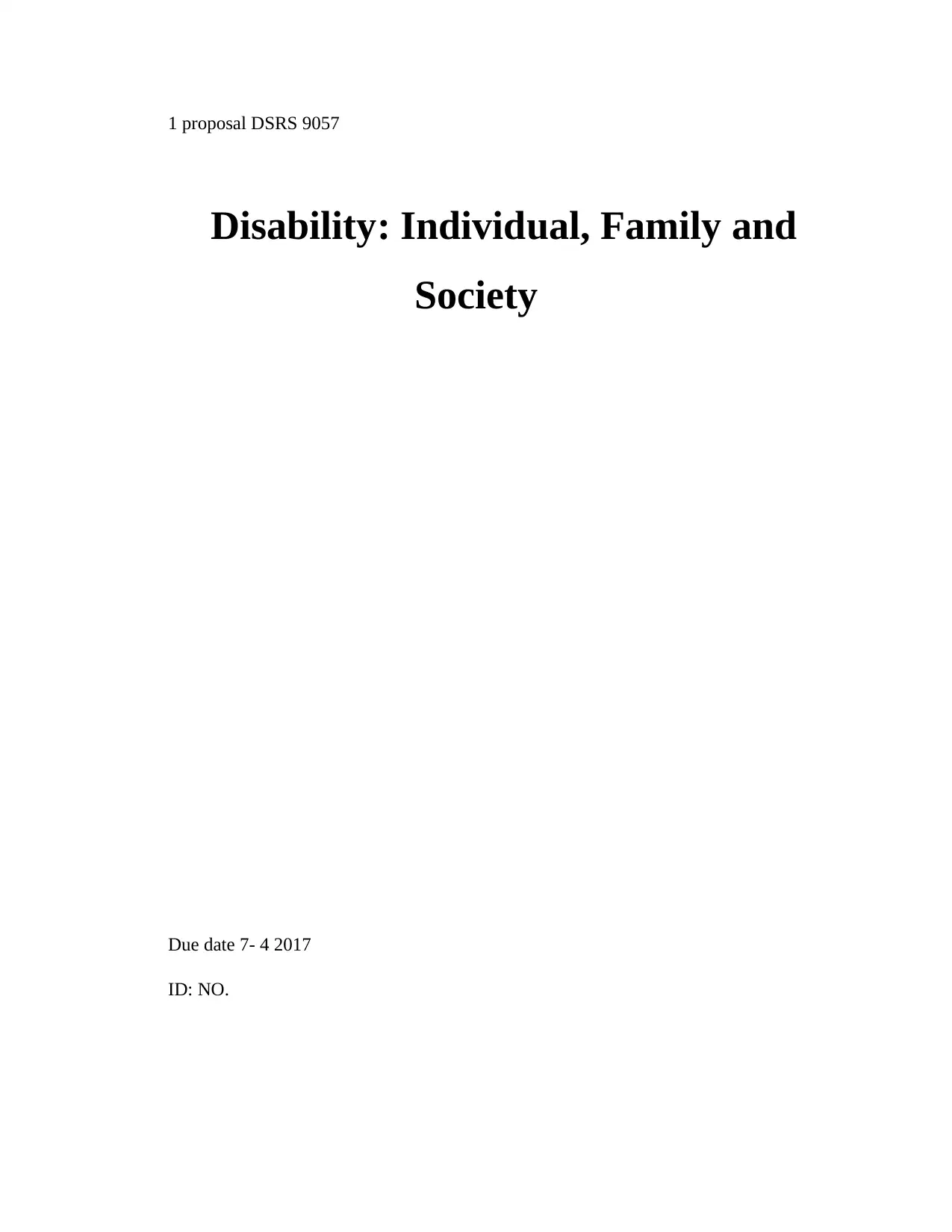
1 proposal DSRS 9057
Disability: Individual, Family and
Society
Due date 7- 4 2017
ID: NO.
Disability: Individual, Family and
Society
Due date 7- 4 2017
ID: NO.
Paraphrase This Document
Need a fresh take? Get an instant paraphrase of this document with our AI Paraphraser

2
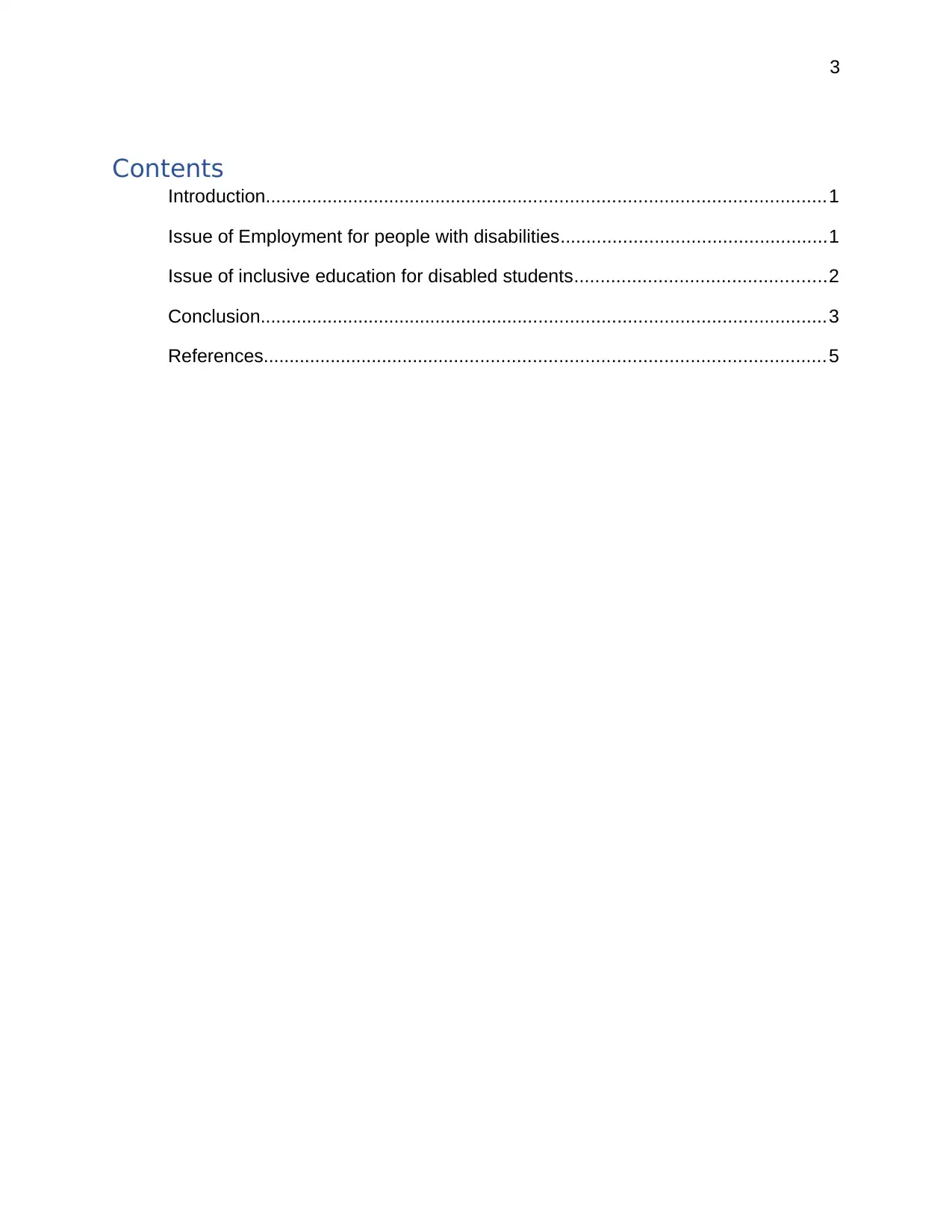
3
Contents
Introduction............................................................................................................1
Issue of Employment for people with disabilities...................................................1
Issue of inclusive education for disabled students................................................2
Conclusion.............................................................................................................3
References............................................................................................................5
Contents
Introduction............................................................................................................1
Issue of Employment for people with disabilities...................................................1
Issue of inclusive education for disabled students................................................2
Conclusion.............................................................................................................3
References............................................................................................................5
⊘ This is a preview!⊘
Do you want full access?
Subscribe today to unlock all pages.

Trusted by 1+ million students worldwide
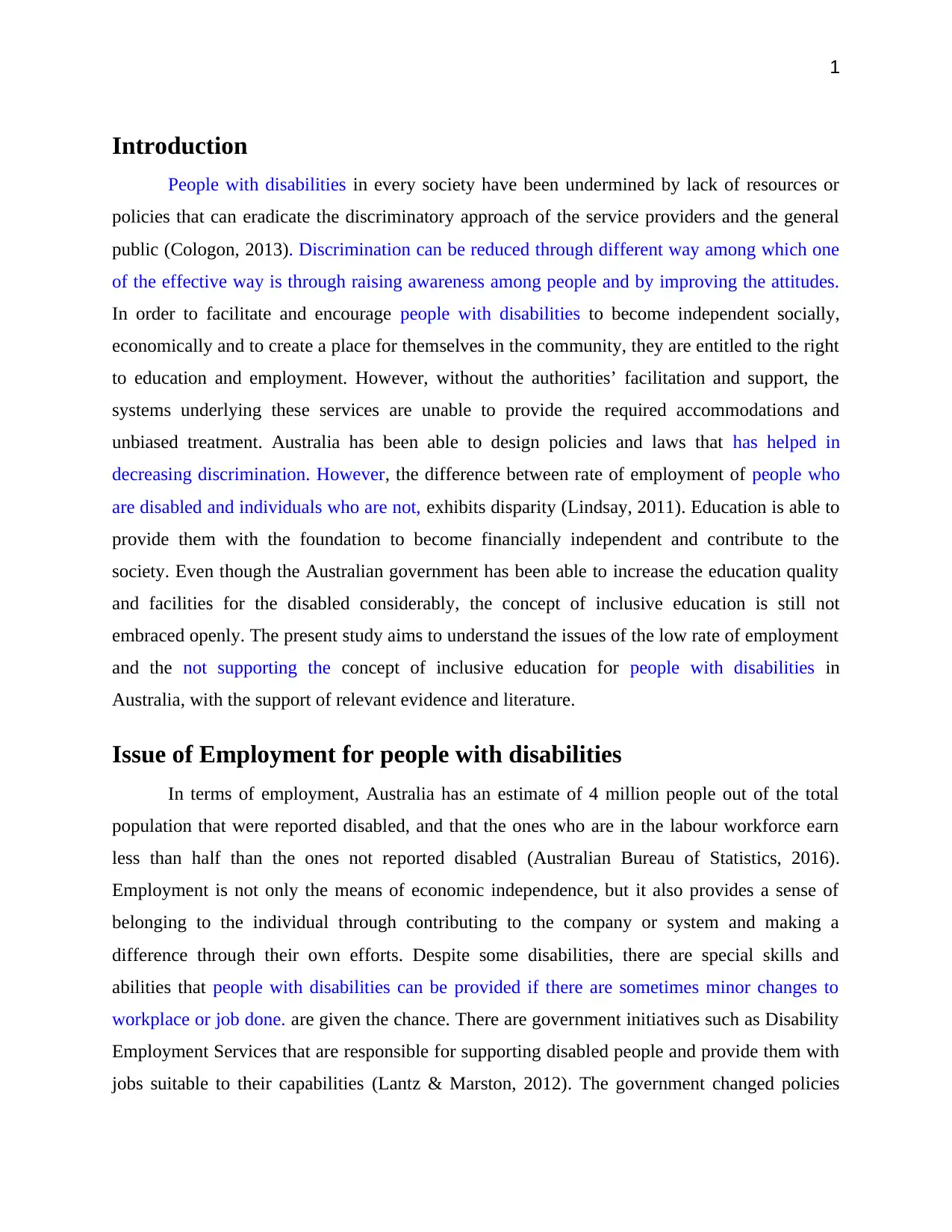
1
Introduction
People with disabilities in every society have been undermined by lack of resources or
policies that can eradicate the discriminatory approach of the service providers and the general
public (Cologon, 2013). Discrimination can be reduced through different way among which one
of the effective way is through raising awareness among people and by improving the attitudes.
In order to facilitate and encourage people with disabilities to become independent socially,
economically and to create a place for themselves in the community, they are entitled to the right
to education and employment. However, without the authorities’ facilitation and support, the
systems underlying these services are unable to provide the required accommodations and
unbiased treatment. Australia has been able to design policies and laws that has helped in
decreasing discrimination. However, the difference between rate of employment of people who
are disabled and individuals who are not, exhibits disparity (Lindsay, 2011). Education is able to
provide them with the foundation to become financially independent and contribute to the
society. Even though the Australian government has been able to increase the education quality
and facilities for the disabled considerably, the concept of inclusive education is still not
embraced openly. The present study aims to understand the issues of the low rate of employment
and the not supporting the concept of inclusive education for people with disabilities in
Australia, with the support of relevant evidence and literature.
Issue of Employment for people with disabilities
In terms of employment, Australia has an estimate of 4 million people out of the total
population that were reported disabled, and that the ones who are in the labour workforce earn
less than half than the ones not reported disabled (Australian Bureau of Statistics, 2016).
Employment is not only the means of economic independence, but it also provides a sense of
belonging to the individual through contributing to the company or system and making a
difference through their own efforts. Despite some disabilities, there are special skills and
abilities that people with disabilities can be provided if there are sometimes minor changes to
workplace or job done. are given the chance. There are government initiatives such as Disability
Employment Services that are responsible for supporting disabled people and provide them with
jobs suitable to their capabilities (Lantz & Marston, 2012). The government changed policies
Introduction
People with disabilities in every society have been undermined by lack of resources or
policies that can eradicate the discriminatory approach of the service providers and the general
public (Cologon, 2013). Discrimination can be reduced through different way among which one
of the effective way is through raising awareness among people and by improving the attitudes.
In order to facilitate and encourage people with disabilities to become independent socially,
economically and to create a place for themselves in the community, they are entitled to the right
to education and employment. However, without the authorities’ facilitation and support, the
systems underlying these services are unable to provide the required accommodations and
unbiased treatment. Australia has been able to design policies and laws that has helped in
decreasing discrimination. However, the difference between rate of employment of people who
are disabled and individuals who are not, exhibits disparity (Lindsay, 2011). Education is able to
provide them with the foundation to become financially independent and contribute to the
society. Even though the Australian government has been able to increase the education quality
and facilities for the disabled considerably, the concept of inclusive education is still not
embraced openly. The present study aims to understand the issues of the low rate of employment
and the not supporting the concept of inclusive education for people with disabilities in
Australia, with the support of relevant evidence and literature.
Issue of Employment for people with disabilities
In terms of employment, Australia has an estimate of 4 million people out of the total
population that were reported disabled, and that the ones who are in the labour workforce earn
less than half than the ones not reported disabled (Australian Bureau of Statistics, 2016).
Employment is not only the means of economic independence, but it also provides a sense of
belonging to the individual through contributing to the company or system and making a
difference through their own efforts. Despite some disabilities, there are special skills and
abilities that people with disabilities can be provided if there are sometimes minor changes to
workplace or job done. are given the chance. There are government initiatives such as Disability
Employment Services that are responsible for supporting disabled people and provide them with
jobs suitable to their capabilities (Lantz & Marston, 2012). The government changed policies
Paraphrase This Document
Need a fresh take? Get an instant paraphrase of this document with our AI Paraphraser
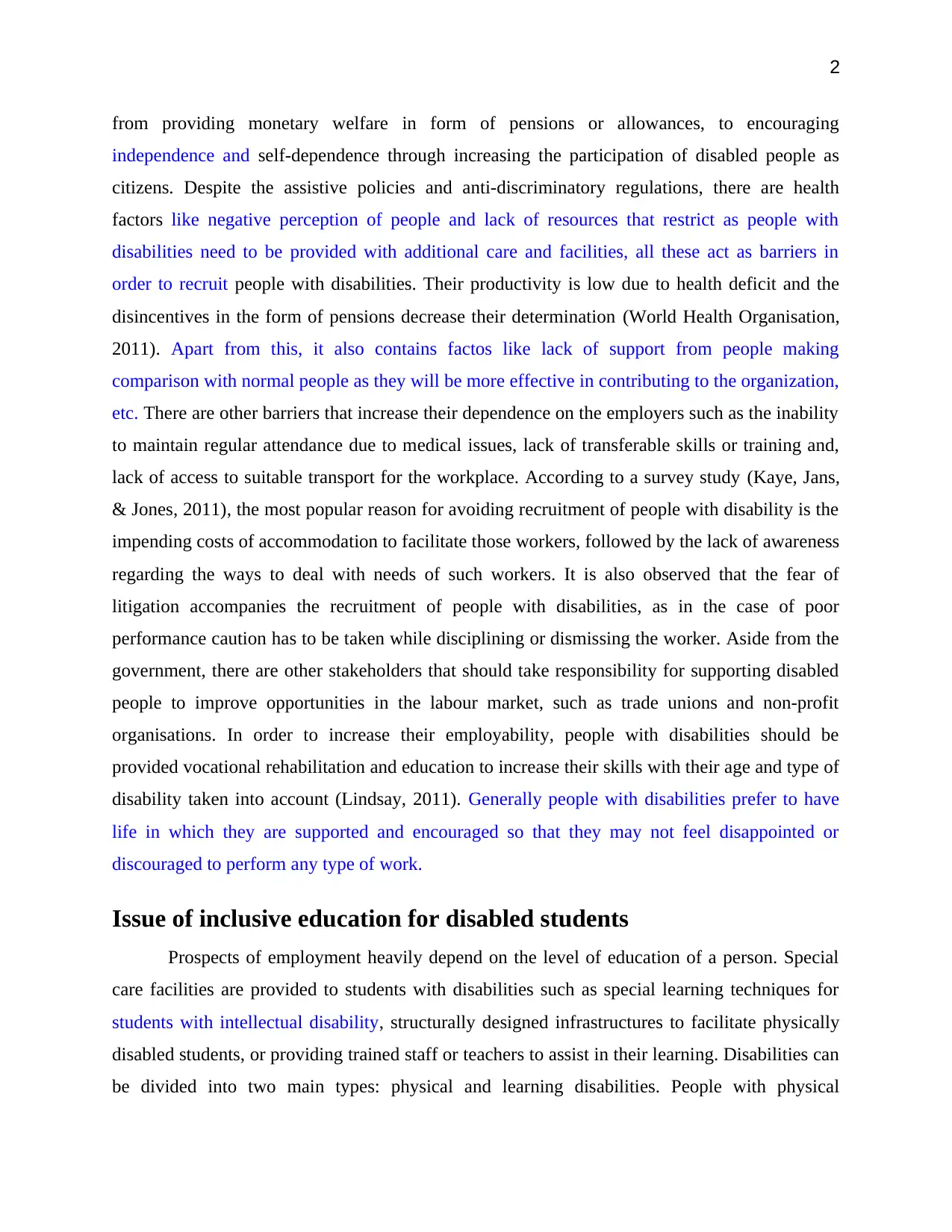
2
from providing monetary welfare in form of pensions or allowances, to encouraging
independence and self-dependence through increasing the participation of disabled people as
citizens. Despite the assistive policies and anti-discriminatory regulations, there are health
factors like negative perception of people and lack of resources that restrict as people with
disabilities need to be provided with additional care and facilities, all these act as barriers in
order to recruit people with disabilities. Their productivity is low due to health deficit and the
disincentives in the form of pensions decrease their determination (World Health Organisation,
2011). Apart from this, it also contains factos like lack of support from people making
comparison with normal people as they will be more effective in contributing to the organization,
etc. There are other barriers that increase their dependence on the employers such as the inability
to maintain regular attendance due to medical issues, lack of transferable skills or training and,
lack of access to suitable transport for the workplace. According to a survey study (Kaye, Jans,
& Jones, 2011), the most popular reason for avoiding recruitment of people with disability is the
impending costs of accommodation to facilitate those workers, followed by the lack of awareness
regarding the ways to deal with needs of such workers. It is also observed that the fear of
litigation accompanies the recruitment of people with disabilities, as in the case of poor
performance caution has to be taken while disciplining or dismissing the worker. Aside from the
government, there are other stakeholders that should take responsibility for supporting disabled
people to improve opportunities in the labour market, such as trade unions and non-profit
organisations. In order to increase their employability, people with disabilities should be
provided vocational rehabilitation and education to increase their skills with their age and type of
disability taken into account (Lindsay, 2011). Generally people with disabilities prefer to have
life in which they are supported and encouraged so that they may not feel disappointed or
discouraged to perform any type of work.
Issue of inclusive education for disabled students
Prospects of employment heavily depend on the level of education of a person. Special
care facilities are provided to students with disabilities such as special learning techniques for
students with intellectual disability, structurally designed infrastructures to facilitate physically
disabled students, or providing trained staff or teachers to assist in their learning. Disabilities can
be divided into two main types: physical and learning disabilities. People with physical
from providing monetary welfare in form of pensions or allowances, to encouraging
independence and self-dependence through increasing the participation of disabled people as
citizens. Despite the assistive policies and anti-discriminatory regulations, there are health
factors like negative perception of people and lack of resources that restrict as people with
disabilities need to be provided with additional care and facilities, all these act as barriers in
order to recruit people with disabilities. Their productivity is low due to health deficit and the
disincentives in the form of pensions decrease their determination (World Health Organisation,
2011). Apart from this, it also contains factos like lack of support from people making
comparison with normal people as they will be more effective in contributing to the organization,
etc. There are other barriers that increase their dependence on the employers such as the inability
to maintain regular attendance due to medical issues, lack of transferable skills or training and,
lack of access to suitable transport for the workplace. According to a survey study (Kaye, Jans,
& Jones, 2011), the most popular reason for avoiding recruitment of people with disability is the
impending costs of accommodation to facilitate those workers, followed by the lack of awareness
regarding the ways to deal with needs of such workers. It is also observed that the fear of
litigation accompanies the recruitment of people with disabilities, as in the case of poor
performance caution has to be taken while disciplining or dismissing the worker. Aside from the
government, there are other stakeholders that should take responsibility for supporting disabled
people to improve opportunities in the labour market, such as trade unions and non-profit
organisations. In order to increase their employability, people with disabilities should be
provided vocational rehabilitation and education to increase their skills with their age and type of
disability taken into account (Lindsay, 2011). Generally people with disabilities prefer to have
life in which they are supported and encouraged so that they may not feel disappointed or
discouraged to perform any type of work.
Issue of inclusive education for disabled students
Prospects of employment heavily depend on the level of education of a person. Special
care facilities are provided to students with disabilities such as special learning techniques for
students with intellectual disability, structurally designed infrastructures to facilitate physically
disabled students, or providing trained staff or teachers to assist in their learning. Disabilities can
be divided into two main types: physical and learning disabilities. People with physical
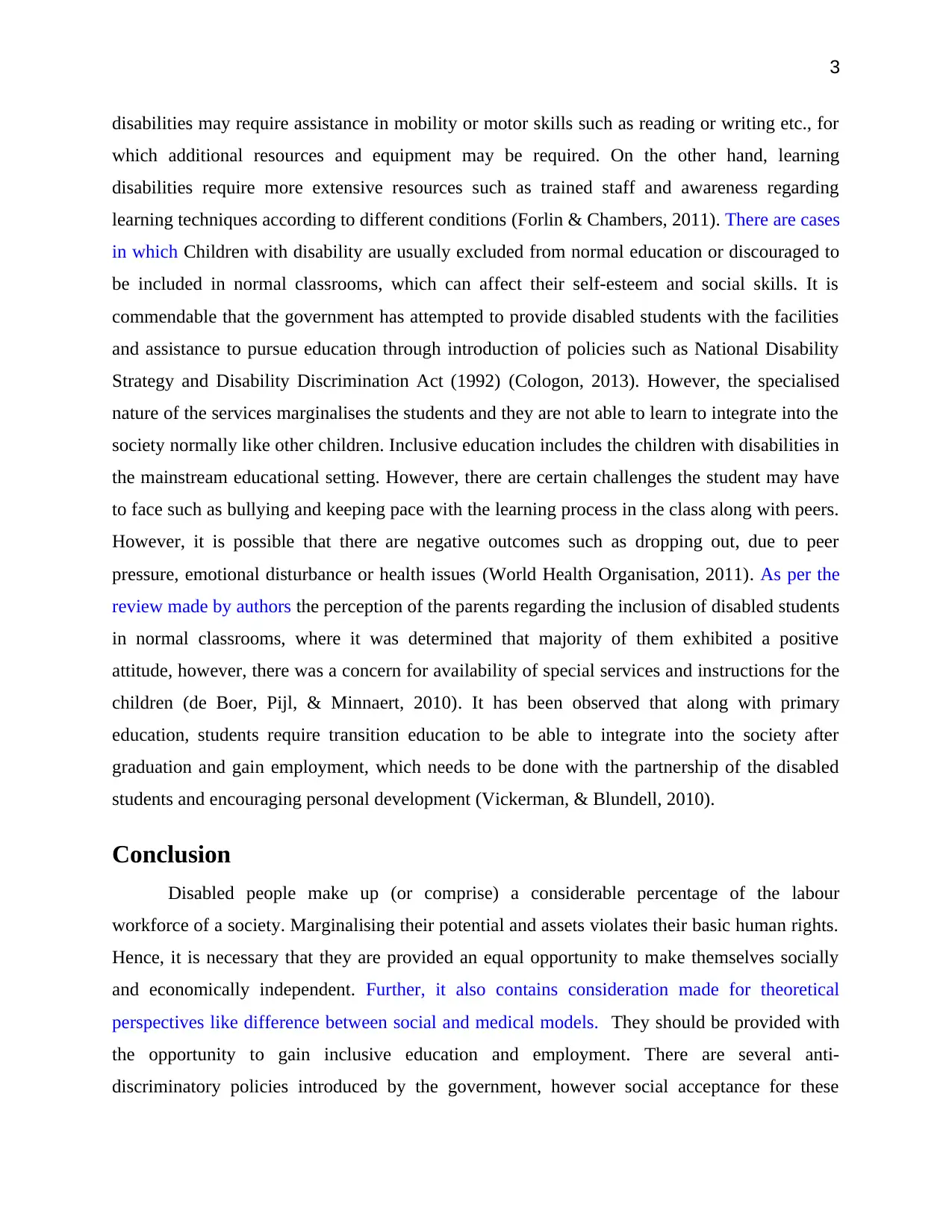
3
disabilities may require assistance in mobility or motor skills such as reading or writing etc., for
which additional resources and equipment may be required. On the other hand, learning
disabilities require more extensive resources such as trained staff and awareness regarding
learning techniques according to different conditions (Forlin & Chambers, 2011). There are cases
in which Children with disability are usually excluded from normal education or discouraged to
be included in normal classrooms, which can affect their self-esteem and social skills. It is
commendable that the government has attempted to provide disabled students with the facilities
and assistance to pursue education through introduction of policies such as National Disability
Strategy and Disability Discrimination Act (1992) (Cologon, 2013). However, the specialised
nature of the services marginalises the students and they are not able to learn to integrate into the
society normally like other children. Inclusive education includes the children with disabilities in
the mainstream educational setting. However, there are certain challenges the student may have
to face such as bullying and keeping pace with the learning process in the class along with peers.
However, it is possible that there are negative outcomes such as dropping out, due to peer
pressure, emotional disturbance or health issues (World Health Organisation, 2011). As per the
review made by authors the perception of the parents regarding the inclusion of disabled students
in normal classrooms, where it was determined that majority of them exhibited a positive
attitude, however, there was a concern for availability of special services and instructions for the
children (de Boer, Pijl, & Minnaert, 2010). It has been observed that along with primary
education, students require transition education to be able to integrate into the society after
graduation and gain employment, which needs to be done with the partnership of the disabled
students and encouraging personal development (Vickerman, & Blundell, 2010).
Conclusion
Disabled people make up (or comprise) a considerable percentage of the labour
workforce of a society. Marginalising their potential and assets violates their basic human rights.
Hence, it is necessary that they are provided an equal opportunity to make themselves socially
and economically independent. Further, it also contains consideration made for theoretical
perspectives like difference between social and medical models. They should be provided with
the opportunity to gain inclusive education and employment. There are several anti-
discriminatory policies introduced by the government, however social acceptance for these
disabilities may require assistance in mobility or motor skills such as reading or writing etc., for
which additional resources and equipment may be required. On the other hand, learning
disabilities require more extensive resources such as trained staff and awareness regarding
learning techniques according to different conditions (Forlin & Chambers, 2011). There are cases
in which Children with disability are usually excluded from normal education or discouraged to
be included in normal classrooms, which can affect their self-esteem and social skills. It is
commendable that the government has attempted to provide disabled students with the facilities
and assistance to pursue education through introduction of policies such as National Disability
Strategy and Disability Discrimination Act (1992) (Cologon, 2013). However, the specialised
nature of the services marginalises the students and they are not able to learn to integrate into the
society normally like other children. Inclusive education includes the children with disabilities in
the mainstream educational setting. However, there are certain challenges the student may have
to face such as bullying and keeping pace with the learning process in the class along with peers.
However, it is possible that there are negative outcomes such as dropping out, due to peer
pressure, emotional disturbance or health issues (World Health Organisation, 2011). As per the
review made by authors the perception of the parents regarding the inclusion of disabled students
in normal classrooms, where it was determined that majority of them exhibited a positive
attitude, however, there was a concern for availability of special services and instructions for the
children (de Boer, Pijl, & Minnaert, 2010). It has been observed that along with primary
education, students require transition education to be able to integrate into the society after
graduation and gain employment, which needs to be done with the partnership of the disabled
students and encouraging personal development (Vickerman, & Blundell, 2010).
Conclusion
Disabled people make up (or comprise) a considerable percentage of the labour
workforce of a society. Marginalising their potential and assets violates their basic human rights.
Hence, it is necessary that they are provided an equal opportunity to make themselves socially
and economically independent. Further, it also contains consideration made for theoretical
perspectives like difference between social and medical models. They should be provided with
the opportunity to gain inclusive education and employment. There are several anti-
discriminatory policies introduced by the government, however social acceptance for these
⊘ This is a preview!⊘
Do you want full access?
Subscribe today to unlock all pages.

Trusted by 1+ million students worldwide
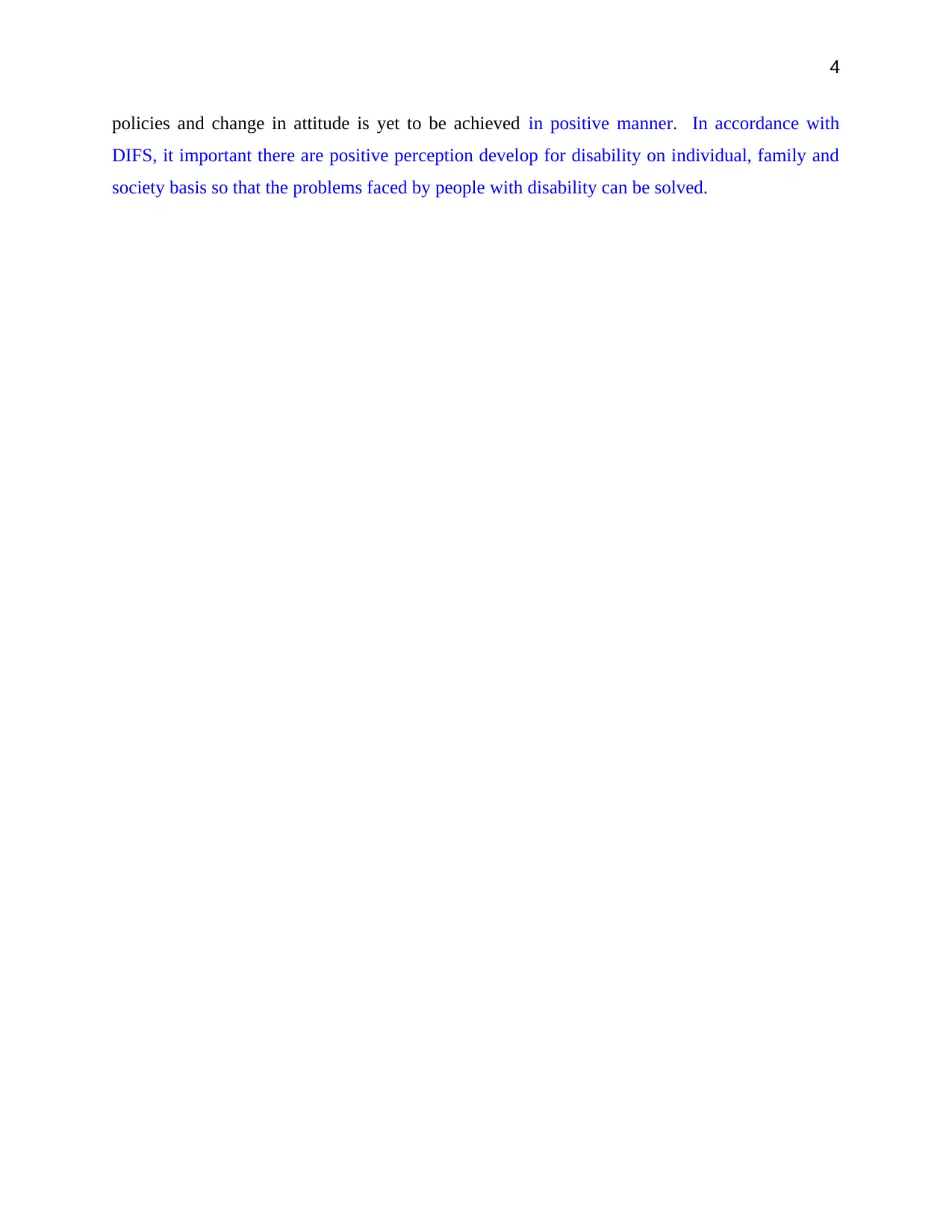
4
policies and change in attitude is yet to be achieved in positive manner. In accordance with
DIFS, it important there are positive perception develop for disability on individual, family and
society basis so that the problems faced by people with disability can be solved.
policies and change in attitude is yet to be achieved in positive manner. In accordance with
DIFS, it important there are positive perception develop for disability on individual, family and
society basis so that the problems faced by people with disability can be solved.
Paraphrase This Document
Need a fresh take? Get an instant paraphrase of this document with our AI Paraphraser
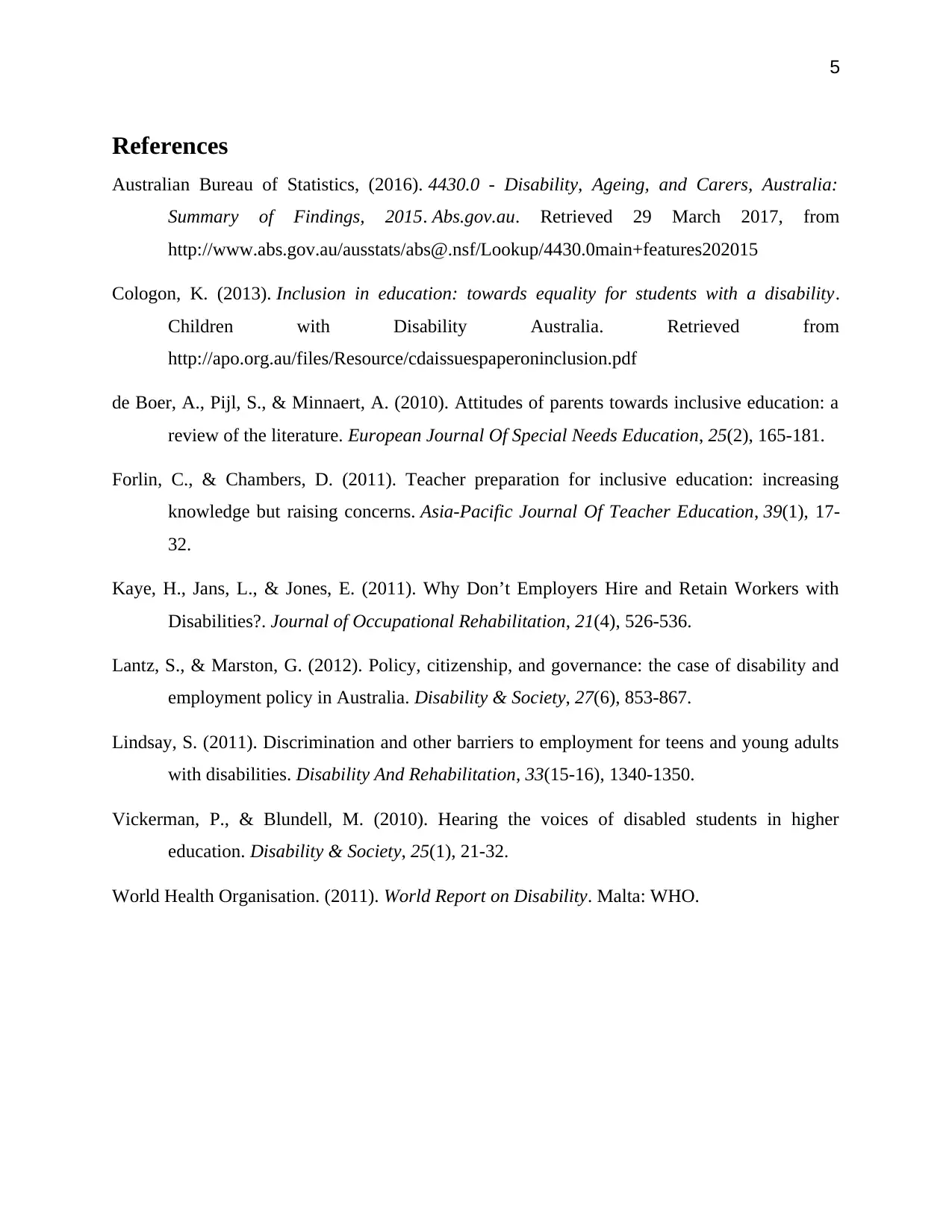
5
References
Australian Bureau of Statistics, (2016). 4430.0 - Disability, Ageing, and Carers, Australia:
Summary of Findings, 2015. Abs.gov.au. Retrieved 29 March 2017, from
http://www.abs.gov.au/ausstats/abs@.nsf/Lookup/4430.0main+features202015
Cologon, K. (2013). Inclusion in education: towards equality for students with a disability.
Children with Disability Australia. Retrieved from
http://apo.org.au/files/Resource/cdaissuespaperoninclusion.pdf
de Boer, A., Pijl, S., & Minnaert, A. (2010). Attitudes of parents towards inclusive education: a
review of the literature. European Journal Of Special Needs Education, 25(2), 165-181.
Forlin, C., & Chambers, D. (2011). Teacher preparation for inclusive education: increasing
knowledge but raising concerns. Asia-Pacific Journal Of Teacher Education, 39(1), 17-
32.
Kaye, H., Jans, L., & Jones, E. (2011). Why Don’t Employers Hire and Retain Workers with
Disabilities?. Journal of Occupational Rehabilitation, 21(4), 526-536.
Lantz, S., & Marston, G. (2012). Policy, citizenship, and governance: the case of disability and
employment policy in Australia. Disability & Society, 27(6), 853-867.
Lindsay, S. (2011). Discrimination and other barriers to employment for teens and young adults
with disabilities. Disability And Rehabilitation, 33(15-16), 1340-1350.
Vickerman, P., & Blundell, M. (2010). Hearing the voices of disabled students in higher
education. Disability & Society, 25(1), 21-32.
World Health Organisation. (2011). World Report on Disability. Malta: WHO.
References
Australian Bureau of Statistics, (2016). 4430.0 - Disability, Ageing, and Carers, Australia:
Summary of Findings, 2015. Abs.gov.au. Retrieved 29 March 2017, from
http://www.abs.gov.au/ausstats/abs@.nsf/Lookup/4430.0main+features202015
Cologon, K. (2013). Inclusion in education: towards equality for students with a disability.
Children with Disability Australia. Retrieved from
http://apo.org.au/files/Resource/cdaissuespaperoninclusion.pdf
de Boer, A., Pijl, S., & Minnaert, A. (2010). Attitudes of parents towards inclusive education: a
review of the literature. European Journal Of Special Needs Education, 25(2), 165-181.
Forlin, C., & Chambers, D. (2011). Teacher preparation for inclusive education: increasing
knowledge but raising concerns. Asia-Pacific Journal Of Teacher Education, 39(1), 17-
32.
Kaye, H., Jans, L., & Jones, E. (2011). Why Don’t Employers Hire and Retain Workers with
Disabilities?. Journal of Occupational Rehabilitation, 21(4), 526-536.
Lantz, S., & Marston, G. (2012). Policy, citizenship, and governance: the case of disability and
employment policy in Australia. Disability & Society, 27(6), 853-867.
Lindsay, S. (2011). Discrimination and other barriers to employment for teens and young adults
with disabilities. Disability And Rehabilitation, 33(15-16), 1340-1350.
Vickerman, P., & Blundell, M. (2010). Hearing the voices of disabled students in higher
education. Disability & Society, 25(1), 21-32.
World Health Organisation. (2011). World Report on Disability. Malta: WHO.

6
⊘ This is a preview!⊘
Do you want full access?
Subscribe today to unlock all pages.

Trusted by 1+ million students worldwide
1 out of 9
Related Documents
Your All-in-One AI-Powered Toolkit for Academic Success.
+13062052269
info@desklib.com
Available 24*7 on WhatsApp / Email
![[object Object]](/_next/static/media/star-bottom.7253800d.svg)
Unlock your academic potential
Copyright © 2020–2025 A2Z Services. All Rights Reserved. Developed and managed by ZUCOL.





